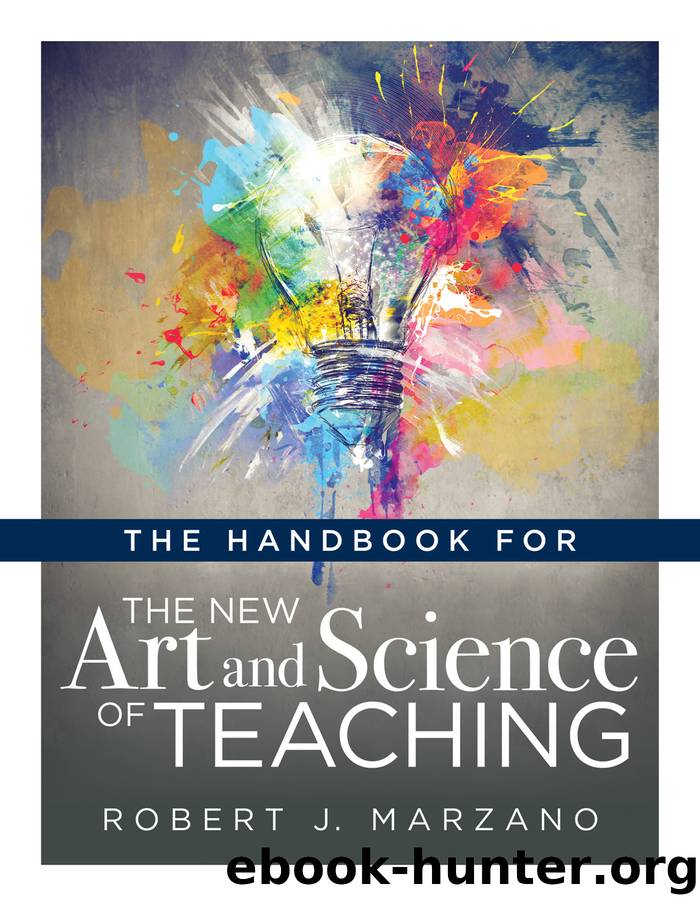The Handbook for the New Art and Science of Teaching: (Your Guide to the Marzano Framework for Competency-Based Education and Teaching Methods). by Robert J. Marzano

Author:Robert J. Marzano [Marzano, Robert J.]
Language: eng
Format: epub
Tags: education, Teaching Methods & Materials, General
ISBN: 9781947604322
Google: WMnDwQEACAAJ
Publisher: Solution Tree Press
Published: 2018-09-21T23:20:54.716953+00:00
Element 25: Using Physical Movement
An effective teacher uses physical movement to maintain student engagement. Research has shown that increased physical activity is associated with higher energy levels (Dwyer, Blizzard, & Dean, 1996; Dwyer, Sallis, Blizzard, Lazarus, & Dean, 2001). Higher energy, in turn, allows students to pay more attention to what is happening in class. Additionally, physical movement increases blood flow to the brain, which facilitates thinking and learning (Jensen, 2005).
There are six strategies within this element.
1. Stand up and stretch
2. Vote with your feet
3. Corners activities
4. Stand and be counted
5. Body representations
6. Drama-related activities
The following sections will explore each strategy to provide you with guidelines to effectively implement this element. Read through each before creating a plan for your classroom. Teachers may use the strategies individually or in combination. Remember, these are not merely activities to be checked off; they are methods of creating a practice that combines your art with the science of using physical movement. Reflect on your use of each strategy by filling out the âStrategy Reflection Logâ on page 331.
Stand Up and Stretch
Periodically, the teacher can ask students to stand up and stretch. This activity is especially useful when students need to change their focus, concentration, or level of engagement, because it causes more blood and oxygen to flow to the brain. The teacher can also instruct students to stretch in their seats if they feel tired or unfocused during class. Following are examples of stretches that teachers can use in class.
⢠Side stretch: Stand with feet slightly more than hip-width apart. Raise one arm above head, and place other hand on the hip. Lean torso toward the side where the hand is on the hip.
⢠Hamstring stretch: Stand with feet about six inches apart. Bend forward and reach arms down toward toes. Make sure head and neck are relaxed; look down toward toes or back through legs.
⢠Quad stretch: Place one hand on desk for balance. Stand on one leg and bend other leg at knee to raise the foot behind the body. Use hand to grasp top of foot or ankle and pull gently up and forward to increase stretch. Be sure to stand up straight throughout; do not bend at waist or hips.
⢠Whole-body stretch: Stand with feet hip-width apart. Raise both arms above head. Stand on tiptoes and try to touch the ceiling.
⢠Lunge: Stand with feet hip-width apart. Take a medium to large step forward with one foot. Forward leg should bend at the knee, keeping the shin vertical, while the back leg stays straight. Keep the torso upright and place hands on hips or raise arms above head.
⢠Triceps stretch: Raise one arm above head. Bend arm at elbow so that the hand touches the back of the same shoulder. Use the opposite hand to grasp the elbow and gently push back to increase the stretch.
⢠Deltoid stretch: With arm straight at shoulder level, reach across body so that the upper arm touches the chest. Use opposite hand to grasp forearm and pull toward body to increase the stretch.
Download
This site does not store any files on its server. We only index and link to content provided by other sites. Please contact the content providers to delete copyright contents if any and email us, we'll remove relevant links or contents immediately.
Kathy Andrews Collection by Kathy Andrews(11730)
The remains of the day by Kazuo Ishiguro(8821)
Paper Towns by Green John(5089)
Spare by Prince Harry The Duke of Sussex(5072)
Industrial Automation from Scratch: A hands-on guide to using sensors, actuators, PLCs, HMIs, and SCADA to automate industrial processes by Olushola Akande(4979)
The Body: A Guide for Occupants by Bill Bryson(4974)
Machine Learning at Scale with H2O by Gregory Keys | David Whiting(4179)
Be in a Treehouse by Pete Nelson(3947)
Never by Ken Follett(3790)
Harry Potter and the Goblet Of Fire by J.K. Rowling(3774)
Goodbye Paradise(3727)
Into Thin Air by Jon Krakauer(3312)
The Remains of the Day by Kazuo Ishiguro(3293)
The Cellar by Natasha Preston(3260)
The Genius of Japanese Carpentry by Azby Brown(3224)
Fairy Tale by Stephen King(3220)
120 Days of Sodom by Marquis de Sade(3180)
The Man Who Died Twice by Richard Osman(2997)
Drawing Shortcuts: Developing Quick Drawing Skills Using Today's Technology by Leggitt Jim(2996)
